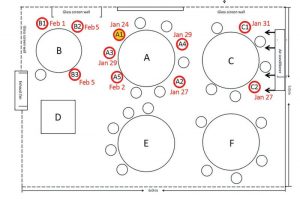Are we paying enough attention to how ventilation affects contagion?
By now, if anyone is unaware of the rules of social distancing or uneducated about the chances of picking up COVID-19 off surfaces that have not been disinfected, they choose to be so. The information is out there ad nauseam. What people might not be so aware of is that health organizations and researchers differ in opinion over whether the virus is airborne—as in, can the droplets be sent further on air currents in an aerosol-like manner and still infect?
Air conditioning contagion in a Chinese restaurant?
One case study of suspected airborne transmission of the virus has gained much attention in the HVAC community: The Guangzhou restaurant in China where nine people may have been affected due to one person who had the virus sitting in the path of an air-conditioning unit. If you look at the diagrams put out by the CDC …
…patient zero in this scenario is A1. It is suspected that strong airflow from the air conditioner ran from the unit, straight across tables A and B, hit the wall, then returned the way it came. Theoretically, air current transported droplets from table C to table A, to table B, and then back to table C. The following questions arise from this case: 1) Are we taking aerosol transmission of COVID-19 seriously enough in the United States? 2) Were the HVAC system conditions in the Guangzhou restaurant optimal or subpar?
Mixed Messages over COVID-19 airborne contagion.
While the World Health Organization and the U.S. CDC say SARS-CoV-2 rarely travels more than six feet in the air and is not an airborne pathogen, what are we to believe about its ability to infect via airflow? Most folks agree that hand washing, disinfecting of surfaces, and social distancing remain the priority to prevent infection. However, worldwide, the importance of proper building ventilation has either been neglected, disputed, or revered as a vital addition to our anti-infection arsenal.
To most HVAC engineers, it’s no surprise that the American Society of Heating, Refrigerating, and Air-conditioning Engineers (ASHRAE) established an Epidemic Task Force and has this to say, “Ventilation and filtration provided by heating, ventilating, and air-conditioning systems can reduce the airborne concentration of SARS-CoV-2 and thus the risk of transmission through the air. Unconditioned spaces can cause thermal stress to people that may be directly life threatening and that may also lower resistance to infection. In general, disabling of heating, ventilating, and air-conditioning systems is not a recommended measure to reduce the transmission of the virus.” As well, the organization has determined (in its April 14th, 2020 Position Document on Infectious Aerosols) that, “The risk of pathogen spread, and therefore the number of people exposed, can be affected both positively and negatively by the airflow patterns in a space and by heating, ventilating, and air-conditioning (HVAC) and local exhaust ventilation (LEV) systems.”
Can we assume poor ventilation proliferates the spread of COVID-19?
Further studies into the Guangzhou restaurant in China suggest that window exhaust fans were not functioning and there was no outdoor air supply in the restaurant. Under such conditions, it seems likely that strong airflow delivered the virus to patrons in the line of fire.
With restaurants reopening in the United States, can we learn anything from the Guangzhou study? Can we assume poor ventilation can move the virus further than expected? What does this study suggest might happen in apartment buildings with poor HVAC systems? As a result of the study, researchers at Guangzhou Yuexiu District Centers for Disease Control and Prevention suggests restaurants screen for temperatures, increasing the distance between tables, and improve ventilation.
We’ve said it before, and we’ll say it forever moving forward: Ventilate! Ventilate! Ventilate. It is key to health, comfort, and productivity … and it could also be a component in safer working conditions during a pandemic. ASHRAE advocates, “Dilution and extraction ventilation, pressurization, airflow distribution and optimization, mechanical filtration, ultraviolet germicidal irradiation (UVGI), and humidity control are effective strategies for reducing the risk of dissemination of infectious aerosols in buildings and transportation environments.”
Are superior ventilation practices perfect? ASHRAE contends, “Even the most robust HVAC system cannot control all airflows and completely prevent dissemination of an infectious aerosol or disease transmission by droplets or aerosols. An HVAC system’s impact will depend on source location, strength of the source, distribution of the released aerosol, droplet size, air distribution, temperature, relative humidity, and filtration. Furthermore, there are multiple modes and circumstances under which disease transmission occurs. Thus, strategies for prevention and risk mitigation require collaboration among designers, owners, operators, industrial hygienists, and infection prevention specialists.”
HVAC solutions for healthier indoor air.
At BPE, Inc., we advocate for careful consideration of HVAC when reopening businesses. We have already designed superior energy recovery ventilation modules that utilize high-grade filters, offer 70% to 90% Thermal Efficiency, and make use of our patented Regenerative Condensate Return® technology for keeping relative humidity levels in range (40% to 60%) for minimizing proliferation of the COVID-19 virus. Our ERV units … from our BPE-XE-MIR-200-i all the way up to our industrial modular units … excel at bringing fresh outdoor air indoors to displace the air folks have been breathing into around you. And because our true direct counter-flow, Air-to-Air heat exchangers allow virtually no mixing of incoming and outgoing air, you’ll know your indoor air is routinely refreshed … not recirculated.
We thought we were passionate about our mission to provide pristine indoor air quality before the pandemic. Now, it’s even more critical that we share our expertise in designing the best HVAC system for your home or commercial building. Give us a call, share your unique situation, and we’ll get you breathing the best air you can under our world’s current circumstances.
Contact Us


